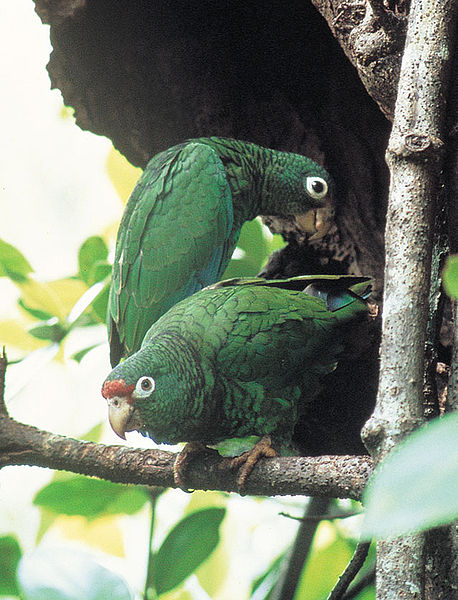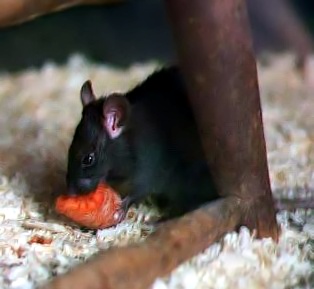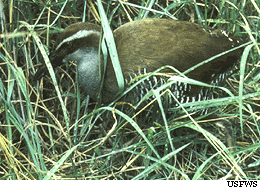People who breed canaries, shama thrushes and other noted songsters often comment that housing males within hearing distance of one another improves the quality of their songs. This theory has now been validated by researchers studying song sparrows (Melospiza melodia) at the University of Miami.
Typical and Improved Songs
 It seems that male song sparrows stick to their “usual” repertoire under normal circumstances – i.e. when calling to announce the ownership of their territory. However, when challenged by intruding males, song sparrows dramatically improve the quality of their songs, selecting note ranges and song speeds that are difficult to perform.
It seems that male song sparrows stick to their “usual” repertoire under normal circumstances – i.e. when calling to announce the ownership of their territory. However, when challenged by intruding males, song sparrows dramatically improve the quality of their songs, selecting note ranges and song speeds that are difficult to perform.
Whether this is to convince a female or male (or both) of the singer’s vigor has not yet been established, but clearly the birds are physically changing their songs in response to a hostile situation. This finding contradicts the long-held assumption that, once acquired, male birds’ song patterns are largely static.
Practical Applications
The song sparrow findings may eventually shed light on the acquisition of language in people, as similar brain pathways seem involved. Those of you who keep groups of canaries, green singing finches or other songbirds may wish to experiment a bit as well, to see if some competition spurs your pets to new musical heights.
Thoughts on the Song Sparrow
As for myself, the first time I hear a song sparrow call (whether the song is “improved” or not!) each late winter is a thrill, assuring me that warmer days are not far off. In years past, I heard these little fellows only near salt marshes, but am happy to report that they have now expanded into suburban yards and city parks in and near NYC.
Further Reading
You can hear a song sparrow’s call and read related field observations at
http://www.sitkanature.org/wordpress/2007/03/15/singing-song-sparrow/.
Please also see my article The Role of Learning and Instinct in Bird Song for more information on this and related topics.
Image referenced from Wikipedia and originally posted by Factumquintus
 That Bird Blog – Bird Care and History for Pet Birds
That Bird Blog – Bird Care and History for Pet Birds

 Toucan bills are perhaps the best known of all bird appendages. Comprising 40% or more of the toucan’s total surface area, these long, colorful structures were thought to serve primarily as fruit gathering tools and, perhaps, to attract mates. However, research involving the toco toucan (Ramphastos toco), which sports the largest bill of all, has yielded some surprising new information.
Toucan bills are perhaps the best known of all bird appendages. Comprising 40% or more of the toucan’s total surface area, these long, colorful structures were thought to serve primarily as fruit gathering tools and, perhaps, to attract mates. However, research involving the toco toucan (Ramphastos toco), which sports the largest bill of all, has yielded some surprising new information. The Puerto Rican Amazon is the only parrot native to a US territory; it is also distinguished by quite possibly being the bird that helped lead Columbus to land on his first voyage (please see article below).
The Puerto Rican Amazon is the only parrot native to a US territory; it is also distinguished by quite possibly being the bird that helped lead Columbus to land on his first voyage (please see article below). The Puerto Rican Amazon’s decline is largely due to deforestation. It nests only in pre-existing holes in tall, mature trees. When these trees are cut, the parrots cannot nest, or they use sites that are vulnerable to predators, competitors and hurricanes.
The Puerto Rican Amazon’s decline is largely due to deforestation. It nests only in pre-existing holes in tall, mature trees. When these trees are cut, the parrots cannot nest, or they use sites that are vulnerable to predators, competitors and hurricanes. Attention to breeding birds in public and private collections, along with increased legal protection, has helped a great many species to recover from earlier population crashes. In some instances, rescue efforts represent the only hope for a species, as none survive in the wild. However, upon reviewing species status reports recently, I was dismayed to see that bad as opposed to good news prevailed. From well known pet trade parrots to recently described Asian swallows, wild birds everywhere face grave threats.
Attention to breeding birds in public and private collections, along with increased legal protection, has helped a great many species to recover from earlier population crashes. In some instances, rescue efforts represent the only hope for a species, as none survive in the wild. However, upon reviewing species status reports recently, I was dismayed to see that bad as opposed to good news prevailed. From well known pet trade parrots to recently described Asian swallows, wild birds everywhere face grave threats. Indo-Malayan birds, Asian vultures and albatrosses face particularly hard times, with many species in severe decline.
Indo-Malayan birds, Asian vultures and albatrosses face particularly hard times, with many species in severe decline. In the Oxford University experiment, 5 New Caledonian crows were presented with a series of tools, some of which were out of reach, and an unreachable food item. All five crows figured out the dilemma in sort order – four on the very first try.
In the Oxford University experiment, 5 New Caledonian crows were presented with a series of tools, some of which were out of reach, and an unreachable food item. All five crows figured out the dilemma in sort order – four on the very first try. Of course we all have our parrot stories…please write in with some that might compete with these crows!
Of course we all have our parrot stories…please write in with some that might compete with these crows!